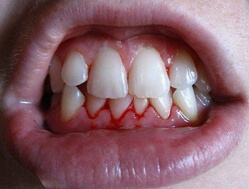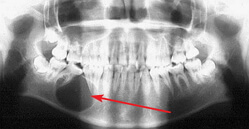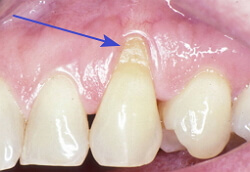Dislocation of the tooth: causes, symptoms and treatment
 Today we will talk about our teeth. Very few people have heard of such a definition as "dislocation of the tooth."This term means damage to the ligamentous apparatus of the tooth. And this phenomenon leads immediately to the displacement of the tooth in the hole. Most often the frontal teeth of the upper jaw are susceptible to this disease. But sometimes it happens on the bottom.
Today we will talk about our teeth. Very few people have heard of such a definition as "dislocation of the tooth."This term means damage to the ligamentous apparatus of the tooth. And this phenomenon leads immediately to the displacement of the tooth in the hole. Most often the frontal teeth of the upper jaw are susceptible to this disease. But sometimes it happens on the bottom.
Causes of
The most common dislocation of the tooth is due to impact, fall. This can happen because of the unprofessional removal of the adjacent tooth. In fact, there are plenty of reasons. With a dislocation, a fracture of the alveolar wall and even a tooth can occur.
The most common reasons:
- for trauma and tooth blow:
- various bad habits( opening of the bottle cap or jar with the teeth);
- when biting off very stiff food( like rubber);
- often the removal of teeth leads to dislocation.
In general, with good periodontal condition, dislocation of the tooth is unlikely. After all, then you need a huge effort to make this happen. Therefore, the chances are very small. But with the resorption of bone tissue this can happen even from stiff food and impact to the jaw.
Common Symptoms
How do you know if you have a tooth dislocation? First of all, we will consider the types of dislocation.
There is incomplete, full and disfigured dislocation. When incomplete, a partial displacement of the root from the alveolus occurs. But when completely drops out completely from the hole. It remains to understand what a "pitted" dislocation is. Usually it is manifested by a full or partial displacement of the tooth toward the body of the jaw. This leads to the destruction of bone tissue.
- For example, a complete dislocation can occur with a complete rupture of bone and ligament of the tooth. It happens after a strong blow to the crown. Usually, the frontal teeth of the upper jaw suffer. Most often, these are the central incisors. When examining the tooth is no longer in the hole, and it bleeds. There are damage to the tissues around. It is necessary to immediately consult a dentist. Usually the tooth is brought with you. Maybe it can be saved.
- With partial dislocation, the tooth moves and changes its place in the row. A man complains of toothache due to the mobility of the tooth itself. On examination, the displacement of the injured tooth is immediately visible. It can move in any direction. He does not move beyond the limits of the series, but this does not make the pain less. The gums can bleed and swell, there is a possibility of rupture. With this dislocation, the root of the tooth is displaced vestibularly. This problem can lead to adverse consequences. For example, to the curvature and shortening of the root, as well as to chronic periodontitis and the root cyst.
- A pitted dislocation is often called an intrusion of the tooth. The tooth is completely or half submerged in the alveolus. Suffer from this frontal teeth of the upper jaw. Partly or completely may break the aerodontal fibers. Patients complain of pain, and the tooth after the injury may become less or it is not visible at all, as it plunged inside. The dentist can immediately determine the cause of the pain and try to eliminate it. Therefore, if you have a jaw injury and you feel pain in your teeth, you should immediately go to your dentist. You should not expect a miracle, because a dislocation can lead to adverse consequences.
Treatment of dislocation of the tooth
First of all, we must think about preserving the tooth. The dentist checks the integrity of the bone tissue at the root. If it is kept half by the length of the root of the tooth, then everything is in order. Then under anesthesia it will be possible to establish a tooth on a former place. Then, splinting is performed to avoid further tooth mobility.
Determine the state of the pulp of the tooth. Very often, with displacement, a vascular-neural bundle may break. In this case, the pulp can stay in order. If there is necrosis, then you have to remove the pulp. It can be checked very simply with the help of electric shock. In the first 5 days after injury, a decrease in the excitability of the pulp may be due to a stroke. So carry out a re-diagnosis. And if the pulp does not react, then it should be removed. When striking, the beam always breaks. In this case, the pulp must be removed. The operation should be recommended as early as possible. Otherwise, the crown of the tooth will turn a dark color.
In severe injuries, one can observe a complete dislocation. And the treatment consists in tooth re-implantation. The operation takes place under the guidance of an experienced surgeon. First, the tooth is fractured, then the pulp should be removed and the channel is sealed at the end. Then treat the antiseptic hole and root of the tooth and inject the tooth into place. Sometimes, to fix it, it is sewn.
If the operation is performed within the first 30 minutes after the injury, the tooth may persist for many years. Otherwise, within a month, the root dissolves.
How is partial incomplete tooth dislocation treated?
Treatment begins with the repositioning of the tooth itself and fixing it( with the aid of a bus-kappa or a bus-brace).The patient sits down on a sparing diet, eats only mashed potatoes and broths. Inspection is carried out once a month.
If you are interested, we will explain what the "tire-bracket" and "tire-kappa" are. The bracket can be wire or belt. It is made of stainless wire up to 1 mm in thickness. Fixation occurs on both sides of the dislocation with the aid of a ligature wire. The kappa tire is made of plastic. It can change the bite of a person.
How is the treatment of complete dislocation of the tooth?
First, the pulp is removed and the canal is sealed. Then we have the process of replantation on our turn. For a month we sew a tooth. It is necessary to observe a diet during treatment.
First, assess the well to understand the condition of the root. If the hole is destroyed, then the boundaries of the alveoli do not determine. Replantation depends on the age of the patient and the condition of the tooth. Various factors are taken into account. The tooth is replaced when the tooth is returned to its original location. After 1.5 months after the operation, you can try other types of tooth engraftment. For example, engraftment through periodontitis. This is the most optimal way to preserve the vitality of tissues. You can try to engraft by the type of synostosis. Some use a mixed type of engraftment - this is periodontal-fibrous-bone.
You need to be careful because the dislocation of the tooth has its negative consequences. And with a trauma you should immediately go to the dentist and preferably on the same day. So you can save your tooth.



